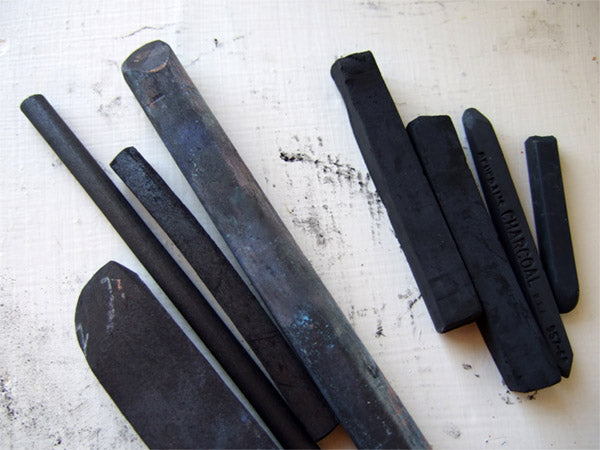Technical Transformations:
The Evolution of the Charcoal Medium

Vine Charcoal (left) and Compressed Charcoal (right)
The story of vine and compressed charcoal begins with the initial discovery by Earth’s earliest humans of charcoal’s general viability as a source of fuel. These cultures discovered this potential by heating carbon-based materials and almost simultaneously began experimenting with charcoal’s potential for artistic expression (for more on this early artistic history, check out this post).
Today’s vine charcoal, often grouped with willow charcoal, is perhaps most akin to those original charcoal sticks created by our earliest ancestors (click here for another article on the distinctions between vine and willow charcoal). Vine charcoal was originally prized because it offers a subtle grey tone and can be easily lifted from most surfaces. This contributed to its early popularity as a means for sketching. For generations, until the Middle Ages, artists relied on vine charcoal to conjure preparatory images for larger commissions, such as tapestries or paintings.
By the time of the Renaissance, the challenge to get vine charcoal to stick to a surface began to prove problematic. During the 15th and 16th centuries artists began more vigorous experiments with powdered charcoal to achieve more precision and an increased coloristic intensity. This was in part because charcoal drawings, along with those rendered in chalk or pastel, experienced an elevated status because they conveyed a sense of immediacy on the part of the artist. As a result, some figures, like Jacopo Tintoretto, would grind their charcoal into powder and then suspend it in linseed oil, the same suspension used for oil paints, to create a rich and more fixed color. This gave Renaissance artists a more fluid application of charcoal, as if they were working in ink or paint, for example, and it also laid the groundwork for the technical innovation of compressed charcoal in the generations to come.

Jacopo Tintoretto, Study of a Fallen Man, 16th century
While Tintoretto’s technique allowed for a more facile charcoal method, the late 18th century ushered in new thinking that revolutionized the medium. This transition began with the work of French artist Nicolas-Jacques Conté. Frustrated at the lack of graphite available due to the impact of the Napoleonic Wars, Conté ground graphite and charcoal into a powder, mixed this dust with wax or clay, and then pressed it into a mold. The result was the inaugural Conté crayon, and its idea of compressing a pigment mixed with a binding agent gave birth to the notion of compressed charcoal. Produced today by much more modern technological means, compressed charcoal is nevertheless formed in virtually the same way: charcoal is ground into a powder and is then blended with a gum binder to make it stick together. This mixture is then pressed into formed cylinders or squares.
One of the advantages of this type of charcoal is that it offers a deeper, less chalky hue, and the uniformity of each piece allows for clean, long lines that, when smudged, convey a greater tonal variety. This helped to convey the instantaneous expression of the artist to even fuller effect, which was essential for artists like Jean Baptiste Camille Corot, a revolutionary 19th-century figure who ushered in an unprecedented celebration of the natural world and its transience in his work.

Jean Baptiste Camille Corot, The Forest at Coubron c.1872
The development of Nitram charcoal in the mid-20th century, in many ways, continued the evolution of the charcoal medium. Martin Gros, the founder of Nitram charcoal, developed a process by which charcoal sticks could maintain the fiber of the wood, similar to vine charcoal, but could offer the deeper color and finer line of compressed charcoal. Jerzy Niedojadlo has carried this method of production into the 21st century, guaranteeing its versatility will continue to be enjoyed by ateliers and academies for years to come.
Which type of charcoal do you prefer in your work? Of all the artistic effects charcoal can render, what, in your opinion, is its most unique?
